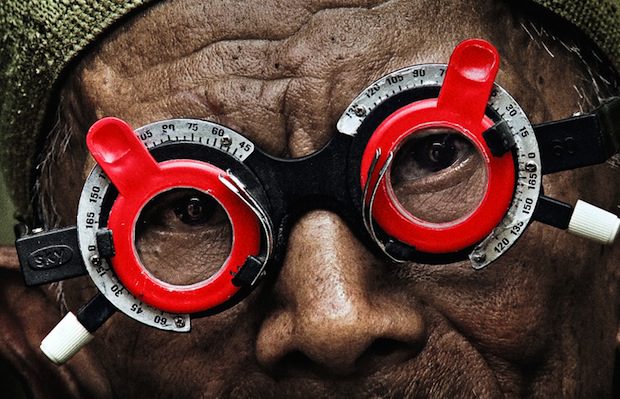The Truth Without Reconciliation Committee

For the extraordinary 2012 documentary “The Act of Killing“, filmmaker Joshua Oppenheimer encouraged participants in the Indonesian death-squad killings of 1965 to reenact their murders of suspected or fabricated Communists. The killers, who have reaped material and political success from their violence, were for the most part happy to oblige. Their reenactments became increasingly baroque and Hollywoodized; they expressed the self-image which made them feel powerful and free, and allowed them to evade remorse. This was not a film about the victims but about the victimizers: the phantasmagoria of their rationalizations.
Now Oppenheimer has released “The Look of Silence”, a companion piece that follows Adi, a 40-something father of two whose brother was killed in ’65, as he confronts his brother’s killers. The movie’s title refers most obviously to the fixed stare with which Adi watches footage of the killers chortlingly reenacting and expounding on the proper methods for throat-slitting and dismemberment.
“The Look of Silence” was made before “The Act of Killing” had been released, so nobody Adi interviews starts out with any suspicions. But Adi explains that he is the brother of someone they killed. He will not let his interviewees get away with easy answers: “I don’t mean to offend you—but I think you’re avoiding your moral responsibility,” he tells one man, striking his chest at the final words as if reciting the Confiteor.
“Act” is probably the greatest documentary I’ve ever seen. “Look” is excellent in its own right, with several powerful scenes of horror, remembrance, or ambiguous quasi-reconciliation, but it’s not as blunt-force essential as the earlier film. The new film has the ultra-crisp and color-soaked visual style of the earlier one, its quick and dramatic cuts, and its attention to the weird little details of life: Two men stroll along a riverbank, interrupting their reminiscences about their days in the death squad to smell some river plants. Adi’s centenarian father is introduced when Adi asks him to sing, and he warbles obligingly, “You’re so sexy! I can’t stand it!” The conversations are sharply-observed; Oppenheimer keeps in a lot of material that less confident directors might have cut, like Adi’s mother saying that she’s never celebrated her birthday because “I don’t believe in that. People get addicted to it.”
“Look”‘s metaphors are visually striking but somewhat obvious: Adi is an eyeglasses salesman, so there’s a lot of, “Can you see better now? Can you see further?” There are symbolic jumping beans, the hard closed shells that jerk and hop convulsively because something alive is hidden inside. Adi’s father doesn’t know his own age—or pretends not to, pretends he is still a carefree 17-year-old. The documents that might have proven his age have been lost long ago.
“Act” took its killers on journeys deep into the most walled-off sections of their psyches. We saw one perpetrator struggle to acknowledge the humanity of his victims, while another tried to get him to get therapy to cure the first symptoms of conscience.
In “Look”, by contrast, people mostly just threaten Adi and tell him to stop talking politics. There are hints that some of these men find their status and self-image fragile, but many others seem utterly self-satisfied. “We should be rewarded with a trip to America,” one says, adding that it wouldn’t need to be an airline trip: He’d be satisfied with just a cruise. There’s a nasty twist toward the end, when Adi finds out that “your neighbors are your persecutors” actually understates his closeness to the perpetrators, but mostly this is simply a portrayal of an exceptionally brave person trying to, fairly literally, speak truth to power. (Before the film showed, an introductory speaker noted that Adi and his family had left their home village in order to escape retaliation.) The movie’s emotional force comes mainly from Adi’s tense, watchful face as he confronts the men who fattened themselves on his family’s pain.
There is one horrifying detail that gets explored in depth, and we watch the daughter of one of the perpetrators learn about it. She, too, holds very still, almost rearing back, holding herself as far away from Adi and the camera as she can. Her father reveals this detail without any hint of shame and even without realizing, it seems, that it would shock her.
Perhaps that’s the most hopeful element of this harrowing film. As with “Act”, the credits for this movie are filled with “Anonymous,” since Indonesians who worked on the movies were afraid to link their names to it. Part of the films’ vertiginous effect is that they allow people who are in power, and have been in power for a very long time, to tell their side of the story—and only in the telling do the perpetrators sometimes start to realize that their side doesn’t look so good. They have been so used to everyone around them living in the world that they created; their story has become normal to them, they inhabit it, but they have never told it all the way to the end. And only when they are comfortable enough to reveal everything do they begin to see the look on other people’s faces.
Eve Tushnet is a TAC contributing editor, blogs at Patheos.com, and is the author of the recently-released book Gay and Catholic: Accepting My Sexuality, Finding Community, Living My Faith.
Comments